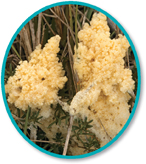21.3 The Ecology of Protists
 What is the ecological significance of photosynthetic protists?
What is the ecological significance of photosynthetic protists? How do heterotrophic protists obtain food?
How do heterotrophic protists obtain food? What types of symbiotic relationships involve protists?
What types of symbiotic relationships involve protists?
algal bloom
food vacuole
gullet
plasmodium
Outline Preview the heads of this lesson to construct an outline of different types of ways that protists obtain energy. Fill in your outline with specific examples as you read.
THINK ABOUT IT After a few days of rain, you notice a small spot of yellow slime at the base of a stand of tall grass. Is it some sort of rot? You mark its position with paint. A few days later, you come back, and it has grown and moved away from the mark. Is it an animal? A fungus? A strange plant? The correct answer is none of the above. It's a protist called a slime mold.

Autotrophic Protists
 What is the ecological significance of photosynthetic protists?
What is the ecological significance of photosynthetic protists?
If you've seen greenish scum growing along the banks of a pond or maybe even at the edges of a poorly maintained swimming pool, you might have called it “algae” without thinking. What you may not have realized at the time is that many of the organisms in that scum were, in fact, protists.
Diversity Biologists long ago realized that the organisms commonly called “algae” actually belong to many different groups. Some (the cyanobacteria) are prokaryotes, some (the green algae) belong to the plant kingdom, and some are protists. Photosynthetic protists include many phytoplankton species and the red and brown algae, as well as euglenas and dinoflagellates. These organisms share an autotrophic lifestyle, marked by the ability to use the energy from light to make a carbohydrate food source.
You might think that all photosynthetic protists are closely related to plants, but this is not the case. In fact, it is the red algae that are most closely related to plants. Many other photosynthetic protists are more closely related to nonphotosynthetic protists. In some cases certain species within a group have lost chloroplasts. In other cases endosymbiosis added a chloroplast to some species but not to their relatives.
 In Your Notebook Preview the next page. Then, make a four-column table using the headings listed. Use the table to record your notes as you read.
In Your Notebook Preview the next page. Then, make a four-column table using the headings listed. Use the table to record your notes as you read.

Table of Contents
- Formulas and Equations
- Applying Formulas and Equations
- Mean, Median, and Mode
- Estimation
- Using Measurements in Calculations
- Effects of Measurement Errors
- Accuracy
- Precision
- Comparing Accuracy and Precision
- Significant Figures
- Calculating With Significant Figures
- Scientific Notation
- Calculating With Scientific Notation
- Dimensional Analysis
- Applying Dimensional Analysis




